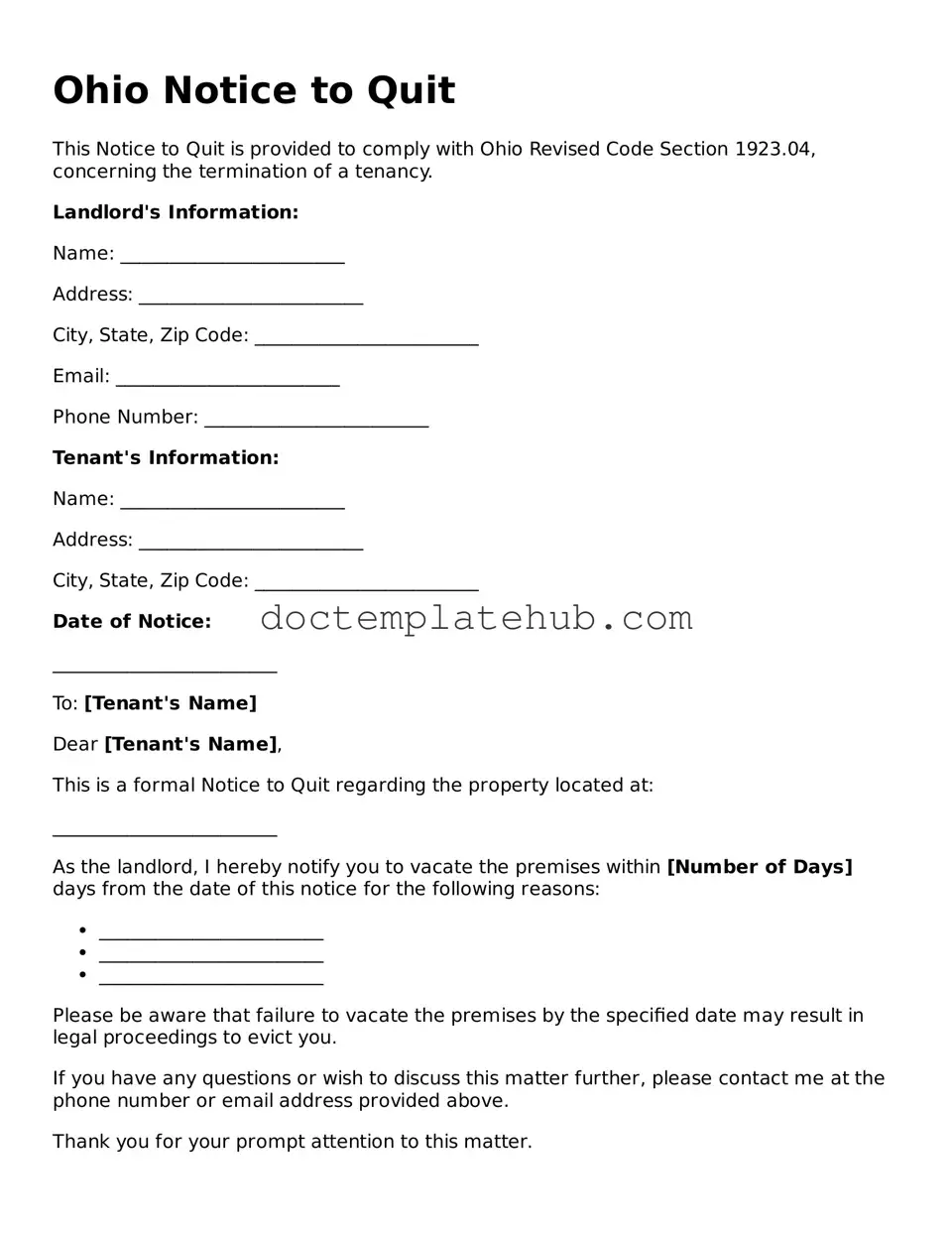The Ohio Notice to Quit form is similar to the eviction notice used in many states. An eviction notice serves as a formal notification to a tenant that they must vacate the rental property due to specific reasons, such as non-payment of rent or lease violations. Like the Notice to Quit, an eviction notice outlines the timeframe within which the tenant must leave the premises, typically providing a grace period to remedy the situation before further legal action is taken.
Another document comparable to the Ohio Notice to Quit is the lease termination letter. This letter is typically issued by landlords when they decide not to renew a lease agreement. It specifies the end date of the tenancy and informs the tenant that they must vacate the property. Both documents aim to communicate the necessity of leaving the property, though the lease termination letter often arises at the conclusion of a lease term.
The demand for possession is another document that parallels the Ohio Notice to Quit. This legal document is filed in court when a landlord seeks to reclaim possession of a rental unit. While the Notice to Quit serves as a preliminary step, the demand for possession is a formal request that initiates legal proceedings. Both documents highlight the landlord's intention to regain control of the property, although the demand for possession typically follows a failure to respond to the Notice to Quit.
In addition, the three-day notice to pay rent or quit is a document used in various jurisdictions, including Ohio. This notice is issued when a tenant fails to pay rent on time, demanding payment within three days or vacating the property. Similar to the Notice to Quit, it serves as a warning and provides the tenant with a specific timeframe to address the issue before further action is taken.
The notice of lease violation is another document that bears similarities to the Ohio Notice to Quit. This notice is issued when a tenant breaches specific terms of their lease agreement, such as having unauthorized pets or excessive noise. It informs the tenant of the violation and often provides a timeframe to correct the issue. Both documents aim to inform tenants of their responsibilities and the consequences of non-compliance.
The notice of non-renewal is also akin to the Ohio Notice to Quit. This document is sent by landlords to inform tenants that their lease will not be renewed at the end of the term. It outlines the requirement to vacate the property by a specific date. While both documents serve to notify tenants of their need to leave, the notice of non-renewal typically occurs at the end of a lease, whereas the Notice to Quit may arise from other issues during the tenancy.
When dealing with mobile homes, understanding the legal intricacies is crucial. For those in need of documentation, a comprehensive Mobile Home Bill of Sale is available, which is essential for ensuring proper ownership transfer. You can find a useful template at this link.
The notice to vacate is another document similar to the Ohio Notice to Quit. This notice can be issued by either the landlord or the tenant, indicating the intent to leave the rental property. It specifies the date by which the tenant must vacate. Both documents serve as formal notifications of a tenant's need to exit the property, though the notice to vacate may be initiated by the tenant in situations where they choose to end their lease.
The notice of default is a document that shares characteristics with the Ohio Notice to Quit. It is often used in mortgage situations, indicating that a borrower has failed to meet their payment obligations. While the context differs, both documents serve as warnings that failure to act may result in loss of property. They emphasize the importance of addressing the underlying issue to avoid further consequences.
The notice of abandonment is another document that resembles the Ohio Notice to Quit. This notice is issued when a landlord believes a tenant has vacated the property without proper notification. It informs the tenant of the landlord's intention to reclaim the property. Both documents address the need for tenants to communicate their intentions regarding the property, emphasizing the importance of maintaining open lines of communication.
Lastly, the notice of intent to terminate tenancy is similar to the Ohio Notice to Quit. This notice is often used by landlords to inform tenants that their tenancy will be terminated for various reasons, including lease violations or non-payment of rent. It outlines the reasons for termination and the timeframe for vacating the property. Both documents serve as formal notifications that a tenant must leave, highlighting the need for tenants to adhere to lease agreements and maintain their responsibilities.
